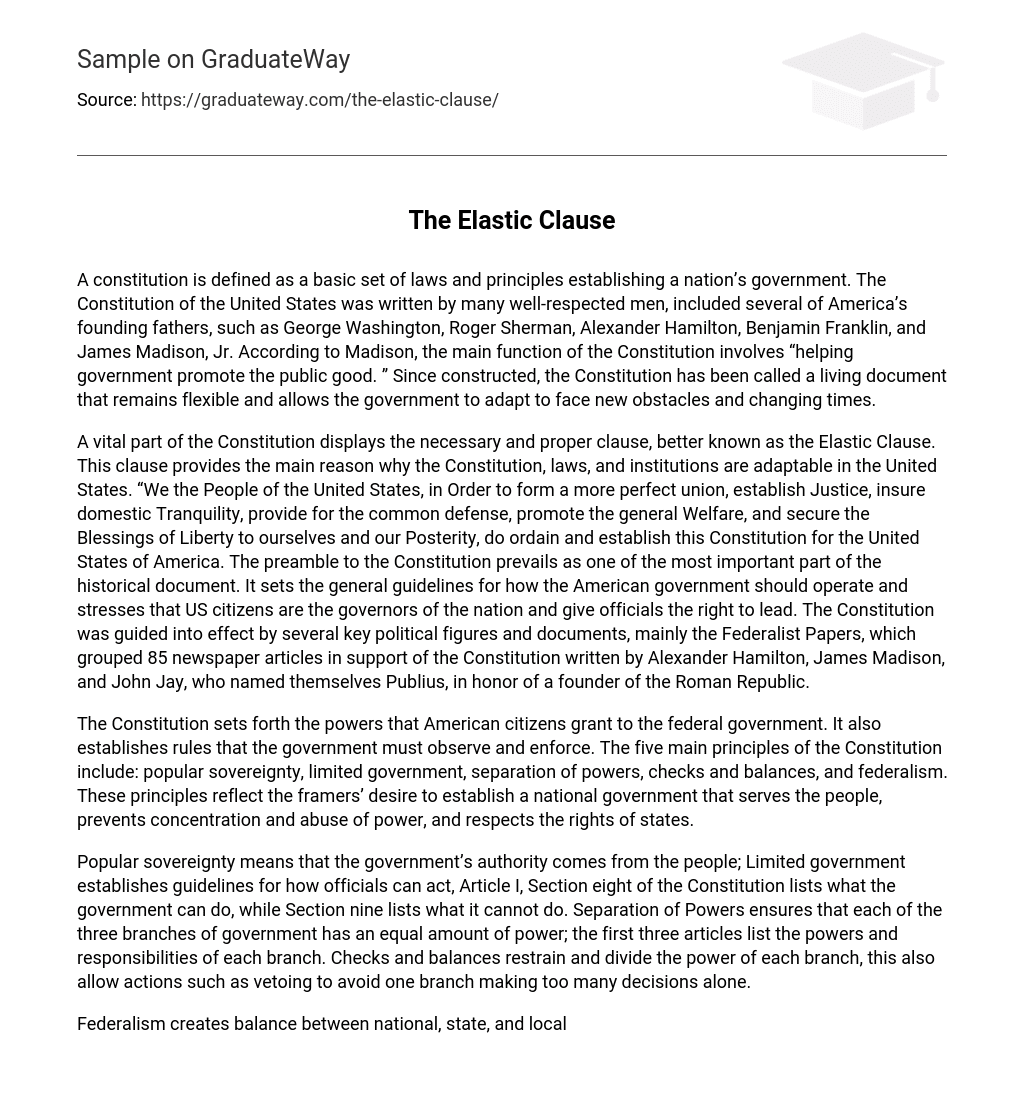The United States Constitution is a crucial set of laws and principles that establishes the government of the country. It was authored by esteemed individuals, including George Washington, Roger Sherman, Alexander Hamilton, Benjamin Franklin, and James Madison, Jr., who are considered America’s founding fathers. As per Madison’s perspective, the primary goal of the Constitution is to aid the government in promoting public welfare. The Constitution has consistently been recognized as a living document that retains its flexibility and enables the government to tackle emerging challenges and evolving circumstances.
The necessary and proper clause, also known as the Elastic Clause, is a crucial component of the Constitution that provides flexibility to the laws and institutions of the United States. The preamble establishes fundamental principles for how the American government should function, highlighting that US citizens govern the nation and delegate authority to officials. Influenced by notable individuals and documents, notably the Federalist Papers, which were 85 newspaper articles written by Alexander Hamilton, James Madison, and John Jay under the pen name Publius in tribute to a founder of the Roman Republic. These papers offered support for ratifying the Constitution.
The Constitution outlines the authority given to the federal government by American citizens and provides guidelines for its operation. It includes five key principles: popular sovereignty, limited government, separation of powers, checks and balances, and federalism. These principles were introduced by the framers to establish a government that serves the people, prevents the concentration and misuse of power, and protects state rights.
The concept of popular sovereignty is that the government’s authority comes from the people, while limited government sets boundaries on officials’ behavior. Article I, Section eight of the Constitution lists the powers given to the government, and Section nine outlines its limitations. The principle of separation of powers ensures that each branch of government (specified in articles one through three) has equal power and responsibilities. Additionally, checks and balances are implemented to control and distribute power among branches, preventing any one branch from making unilateral decisions excessively.
Federalism seeks to uphold a equilibrium between the national, state, and local governments while protecting state government rights. The Constitution can be altered through amendments, which follow a formal process outlined in Article V for both proposal and ratification. By permitting amendments, the government can effectively tackle emerging needs and challenges within the country. Currently, there are 27 amendments to the United States Constitution.
The Bill of Rights, comprising the initial ten amendments, provides an all-encompassing safeguard for personal freedoms and rights. It was ratified shortly after the Constitution, raising concerns initially about favoritism towards larger states and excessive government power. However, in the late 1780s and early 1790s, all thirteen original colonies unanimously agreed to adopt the Constitution as the supreme body of laws for the nation.
Located at the end of Article I, Section 8 in the Constitution, the Elastic Clause is a controversial clause. It grants the government the power and duty to establish laws essential for executing powers granted by the Constitution, as well as other powers given to the United States government or its departments and officers. This provision permits government officials to modify laws and assess their conformity with the Constitution. Moreover, it empowers Congress to extend its authority beyond what is explicitly mentioned in the Constitution. The federal government possesses three categories of powers: expressed (for example, collecting taxes, regulating trade, and declaring war), implied, and inherent.
Inherent powers refer to the powers that naturally belong to any national, sovereign government. On the other hand, implied powers are powers that are suggested by expressed powers and are found in the Elastic Clause. An example of the Elastic Clause being exercised is seen in the aftermath of the 16th amendment, which grants Congress the authority to tax income, resulting in the establishment of the Internal Revenue Service (IRS) to collect these taxes. The debate surrounding the Elastic Clause and Congress’s implied powers has persisted ever since the creation of the Constitution.
In 1819, a significant dispute arose regarding the creation of the United States Bank in 1791. This controversy centered around the Supreme Court case of McCulloch v. Maryland, which was believed by many, including Thomas Jefferson, to infringe upon states’ rights. They argued that Congress did not possess constitutional authority to establish a national bank.
Despite these concerns, the Supreme Court ultimately issued a unanimous ruling in favor of Congress.
The Elastic Clause, found in the United States Constitution, grants Congress the authority to modify laws that are considered necessary and appropriate for fulfilling its constitutional responsibilities. The Founding Fathers established this Constitution as the basis for American governance and legislation, enabling the government to adapt to changing circumstances and ensuring democracy’s ongoing prosperity in America. The Constitution’s ability to adapt is essential for maintaining its long-term success and stability.





